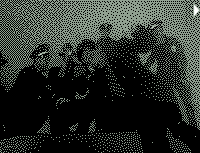April 19, 2008
Cops catch Copo but no Cocaine
Zacarias Copo, believed to be a big player and the missing link in the drug plane landing on the Northern Highway on the night of March 7, 2008, has handed himself over to Orange Walk Police.
He was accompanied by his lawyer, Senior Counsel Simeon Sampson, when he did so last Friday morning April 11.
Copo, 45, was being actively hunted by Orange Walk Police who suspect that he played a major role in the drug smuggling drama which ended in a shoot out between the smugglers and Belize security forces who stormed the plane and captured it.
Police have since booked him on charges which include causing a rogue aircraft to land on the Northern Highway, and the illegal handling of aviation fuel.
He has not been charged with drug trafficking, although it is generally known that the plane brought more than a ton of cocaine from Colombia.
Others who have been charged in the illegal landing of the drug plane include Ervin Canton, Luis Novelo, Victor Torres, Ricardo Rivero, Arnaldo Rivas, Cesar Cananche and Roy Lanza.
All have been charged with obstructing the flow of traffic, landing an aircraft without authority and dealing in aviation fuel without a permit. No one has been charged with cocaine trafficking so far.
The men have been allowed to secure bail in the sum of $10,000.00 each. The next court hearing will be on May 23.
The police have yet to capture the pilot and copilot of the plane, and they have found no trace of the cocaine, which the twin-engine plane reportedly brought from Colombia.
It is generally believed that the pilot and copilot both made it safely out of Belize.
Armed men wielding AK 47 assault rifles emerged out of the darkness and at gunpoint about a mile off the long stretch of the Northern Highway near mile 40 on the night of April 11, this year.
At that time of night traffic was light but a few motorists used their cell phones to call the police.
Police and BDF personnel who were deployed to the area, arrived in time to seize the plane, but the cargo of cocaine had already been shipped out.
It is believed the cocaine was trucked out that same night and smuggled into Mexico.
When Security Forces approached the area, the drug smugglers began to fire their assault rifles at them.
Re-fuelling was interrupted and in the gunfight which followed, one or more of the smugglers got hit. Police and BDF reported no casualties.
As the firefight intensified the drug smugglers withdrew and fled into the bushes, leaving the plane, the refuelling truck and the gear they had brought with them.
Five men were captured in the area and two more were apprehended in Orange Walk Town, but Zacarias Copo, whose truck was used for the refuelling operations, was nowhere to be found.
The truck contained 1,200 gallons of aviation fuel.
Police investigations focused on how the cocaine was shipped out of Belize into Mexico, and how the drug smugglers were able to accumulate 1,200 gallons of aviation fuel without arousing suspicion.
Investigators are not convinced that Copo was the mastermind behind the shipment, and are still looking for the person higher up who master-minded the operation and coordinated with the drug cartel in Colombia.
April 15, 2008
China tops list of world executioners
China defended its use of the death penalty Tuesday, after an Amnesty International report said it carried out the most executions worldwide in 2007.
Chinese authorities executed at least 470 people last year but may have killed as
many as 8,000, according to a report by Amnesty International. The human rights
group says executions were often hidden and that on average China secretly executes
22 prisoners a day, with most killed by a gunshot to the back of the head or by lethal injection.
China responded to the report by saying it tightly controls the use of the death penalty and has no plans to abolish it.
“We have strictly controlled and taken a prudent attitude toward the death penalty to ensure that the death penalty only applies to a small number of criminals who commit serious crimes,” said Foreign Ministry spokeswoman Jiang Yu.
“Conditions are not right” to abolish the death penalty, said Jiang, adding that such a move wouldn’t be accepted by the Chinese people.
Amnesty International said some of the executions were for non-violent crimes such as tax evasion, smuggling and organizing prostitution.
While China’s total number of executions is down from 1,010 in 2006, Amnesty International warned the 2007 number could be higher because China considers death penalty data a state secret and doesn’t make the information public.
“The secretive use of the death penalty must stop: the veil of secrecy surrounding the death penalty must be lifted. Many governments claim that executions take place with public support. People therefore have a right to know what is being done in their name,” said Amnesty International.
Activists have used protests against the Olympic torch relay to draw attention to China’s human rights record, including a recent crackdown in Tibet.
The report said 88 per cent of all known executions took place in five countries:
* China (at least 470).
* Iran (at least 317).
* Saudi Arabia (at least 143).
* Pakistan (at least 135).
* U.S. (42).
Saudia Arabia carried out the most executions per capita, while Iran, Saudia Arabia and Yemen violated international law by executing people younger than 18, said the report.
The organization said at least 1,252 people were executed in 24 countries. Around the world, up to 27,500 people are estimated to be on death row.
‘Naked Nomad’ leaves millions
A MAN who rejected possessions and walked naked around the country has been declared dead, leaving his sister an estate worth millions of dollars.
Victor Flanagan, also known as the “Naked Nomad”, was declared presumed dead in the Supreme Court in Perth last week – more than a decade after he last spoke to his sister.
The West Australian said a multimillion-dollar beachfront property near Busselton would be left to his sister, Violet Georgina Jenkins.
Mr Flanagan had inherited the property after their father’s death.
Mrs Jenkins told the court that she last spoke to Mr Flanagan in 1996, while he was living in Papua New Guinea, the newspaper reported.
He moved to PNG after years of wandering naked around outback Australia.
He would don a sarong when walking through towns and a pair of thongs when there were prickles underfoot.
Mrs Jenkins said loggers at a remote camp in PNG found a naked and dying man in a canoe and she believed it was her brother.
He was buried in a mass grave in the PNG city of Lae, where other unidentified people were laid to rest, she said.
Supreme Court Justice Andrew Beech ruled that it was fair to say that Mr Flanagan, who would have turned 57 this year, was dead.
“It is to be expected that he would have been in contact with (Mrs Jenkins) if he were still alive,” Justice Beech said.
In a newsletter for environmental awareness group The Great Walk, Mr Flanagan was described as “a gentle man who walked this earth with love and care for the environment around him”.
“He walked barefoot from Perth to Papua New Guinea, becoming known as the Naked Nomad, making the news in his plight to share his truth with the outside world,” the newsletter said.
In 1995, Mr Flanagan told a reporter his naked adventures had attracted interest from travellers and police and many gave him and his dog food and water.
He said his goal was simply to be in touch with nature.
April 14, 2008
ANDY PALACIO
BELIZE’S ANDY PALACIO dedicated his entire life to preserving Garifuna music, the enchanting music of the black communities of the Central American countries of Guatemala, Belize, Honduras and Nicaragua.
Thanks to Palacio’s efforts, Garifuna music is today regarded as one of the best schools of world music. By the time of his death on January 19, 2008, in Belize city, Palacio, 47, had gained popularity both in Belize and abroad and had performed in the Caribbean, the Americas and Europe and Asia.
He appeared at the Festival Internacional de Cultura del Caribe in Cancun, Carifesta VI in Trinidad and Tobago, Carifesta VII in St. Kitts-Nevis, the Rainforest World Music Festival in Malaysia, the Antillanse Feesten in Belgium, the World Traditional Performing Arts Festival in Japan and other events in the United States, Canada, Colombia, France, Germany and the UK. He started performing in 1988.
In memory of Palacio, leading Garifuna musicians recently toured the US and Europe to celebrate the life and music of a bandleader and songwriter who spearheaded a revival of the unique music of Central America.
They started their performance in New York on April 4, at the Symphony Space, and will visit Atlanta, Miami, and other cities, concluding on August 29 with a performance in Los Angeles. The tour will promote an album titled Watina (“I called out,” in the Garifuna language), released in the US and Canada on February 27 on the new record label Cumbancha. Dates for the European tour are yet to be released.
WATINA, A 12-TRACK album performed by Palacio and the Garifuna Collective, was acclaimed as one of the best world music releases of 2007. It was declared album of the year on the European World Music Charts and won on several other charts the same year. Watina has been described as the soul of Africa, the spirit of the Caribbean and the heartbeat of Central America, resonating to the unique and threatened Garifuna culture.
Palacio was not only revered as the most popular musician in Belize, but was also a serious musical and cultural archivist with a deep commitment to preserving his unique culture. A long time proponent of Garifuna popular music and a tireless advocate for the maintenance of the Garifuna language and traditions, Palacio had undertaken a new and ambitious direction with the formation of the Garifuna Collective band.
Palacio’s passion can be traced to the history of the Garifuna people.
The Garifuna are descendants of West African slaves who were shipwrecked in 1635 off the coast of what is now the island of St Vincent. The survivors were welcomed by the local Arawak and Carib Indian populations, leading to a distinctive Afro-Amerindian culture and language.
Thus began the history of the Garinagu, more widely known as the Garifuna, one of the most unique and threatened cultures in the Americas. Their tale is one of tragedy and adversity, as well as one of triumph, community and hope.
Called the Black Caribs by the British, the Garifuna lived in relative tranquility for many years, their ranks increased by other escaped slaves who heard about this outpost of free Africans.
After siding with the French in a battle over control over St Vincent, however, the Garifuna were defeated by the British in 1797 and exiled to a small island off the coast of Honduras.
Nearly half of the Garifuna population died en route, but 3,000 people survived, and eventually journeyed out to set up small villages on the Caribbean coasts of Guatemala, Belize, Honduras and Nicaragua.
Today there are roughly 250,000 Garifuna in the world, including immigrant communities in Los Angeles, New York, Chicago and Miami. A small and often oppressed minority in their home countries, the Garifuna have valiantly preserved their heritage over the years in the face of tremendous outside pressures. Recently, however, the forces of globalisation have overwhelmed them, threatening extinction to their unique language, traditions and music.
Fewer children are learning the Garifuna language, performing the songs or memorising the oral histories and stories that serve as the legacy of the culture.
Born and raised in the coastal village of Barranco, Palacio grew up listening to traditional Garifuna music as well as foreign music on radio from neighbouring Honduras, Guatemala, the Caribbean and the United States. He joined local bands while still in high school and began developing his sound, performing covers of popular Caribbean and US Top 40 songs.
However, it was while working with a literacy project on Nicaragua’s Atlantic Coast in 1980 and discovering that the Garifuna language and culture were steadily dying in that country, that a strong cultural awareness took hold and his approach to music became more defined.
He opted for the language and rhythms of the Garifuna, a unique cultural blend of West African and Carib and Arawak Indian language and heritage. “It was a conscious strategy. I felt that music was an excellent medium to preserve the culture. I saw it as a way of maintaining cultural pride and self esteem, especially in young people,” he said on his record label website.
Palacio became a leading figure in a growing renaissance of young Garifuna intellectuals who were writing poems and songs in their native language. He saw the emergence of an upbeat, popular dance form based on Garifuna rhythms that became known as punta rock and enthusiastically took part in developing the form.
Palacio began performing his own songs and gained stature as a musician and Garifuna artiste. In 1987, he was invited to work in England with Cultural Partnerships Ltd, a community arts organisation, and returned to Belize with new skills and a four track recording system. He helped found Sunrise, an organisation dedicated to preserving, documenting and distributing Belizean music.
Palacio and the Garifuna Collective had been planning an extensive tour of the world this year, and Palacio was looking forward to being accompanied by women from the Umalali project, whose album was released on March, 18 this year.
According to the producers, Umalali musicians blend the rich vocal textures of women from the Garifuna communities with echoes of rock, blues, funk, African, Latin and Caribbean music.
The ongoing tour of the Garifuna musicians — consisting of the Garifuna Collective and three women of Umalali — is promoting the album Watina—Jacob Edgar, president of the record company, Cumbancha, told The EastAfrican: “The album has sold well; it is certainly one of the bestselling world music releases of the past year. It was a struggle at first because few people were familiar with Palacio and his music, but the international media response was tremendous, both before and after his death.”
The idea of the Collective came about five years ago when Belizean producer Ivan Duran, Palacio’s long time collaborator, persuaded Palacio to focus on less commercial forms of Garifuna music. Duran and Palacio set out to create an all-star, multigenerational ensemble of some of the best Garifuna musicians from Guatemala, Honduras and Belize.
The Collective unites elder statesmen such as legendary Garifuna composer Paul Nabor, with up-and-coming voices of the new generation such as Aurelio Martinez from Honduras. Rather than focusing on dance sounds like punta rock, the Collective explores the more soulful side of Garifuna music, such as the Latin-influenced paranda, and the sacred dügü, punta and gunjei rhythms.
THE WORLD TOUR FEATURES Aurelio Martinez, whose album Garifuna Soul was highly praised in the world music press; Adrian Martinez, who sang and composed the moving song Baba from the Watina album and who is a rising young star in Belize; and Lloyd Augustine, one of Belize’s most popular young musicians.
“We have no plans to tour Africa at the moment, although one of the members of the Garifuna Collective will be performing regularly and recording with Youssou N’Dour this year,” said Edgar.
Soon after his death, Palacio was announced winner of the Americas Category in the 2008 BBC Radio 3 Awards for World Music. Although decided by the jury in December, the official announcement of the winners was not due to be made by the BBC until April 10.
The government of Belize honoured him with the Order of Meritorious Service in September 2007, and in November, he was named a Unesco Artist for Peace.
In his acceptance speech on receiving the 2007 Womex Award, Palacio said: “I see this award not so much as a personal endorsement but in fact as an extraordinary and sincere validation of a concept in which artists such as myself take up the challenge to make music with a high purpose that goes beyond simple entertainment. I accept this award on behalf of my fellow artistes from all over the world with the hope that it will serve to reinforce those sentiments that fuel cultures of resistance and pride in one’s own.” Palacio lived in San Ignacio, Belize, where he was accorded a state burial. He died of respiratory failure after a stroke and heart attack.
April 13, 2008
Bangladesh workers riot over soaring food prices
About 20,000 workers rioted over high food prices and low wages on Saturday close to the Bangladesh capital Dhaka, police said, amid spreading global unrest over soaring grocery costs.
Police fired tear gas and used batons to break up the protests and at least 50 people were injured, most of them police officers.
About 20,000 textile workers from more than a dozen factories went on the rampage in Fatullah, 20 kilometres (12 miles) south of Dhaka, demanding better pay amid soaring rice prices, police chief Bhuiyan Mahbub Hasan said.
Police said they wrecked cars and buses, vandalised factories and hurled bricks and stones at police.
“They became unruly demanding higher wages, saying their current wages don’t even meet basic food needs,” police sub-inspector Shafiqul Islam said.
Hasan said representatives of the manufacturers, labour and the military would meet in an attempt to defuse the unrest.
The riots came after the government said food prices, notably rice, which is a staple in Bangladesh, had doubled in the past year due to a massive production shortfall after devastating floods and a cyclone.
The price of rice is a key issue in impoverished Bangladesh, where households are estimated to spend nearly 70 percent of their income on food.
The Bangladesh violence came amid mounting unrest globally over soaring food costs.
At least five people have died in similar protests over high food and fuel prices in Haiti, while disturbances have rocked Egypt, Cameroon, Ethiopia, the Philippines, Indonesia and other countries in the past month.
The country’s food minister said early this month that the domestic grain output shortfall and global food price rises had created a “hidden hunger” in the country and that it had intensified in recent months.
The country’s garment manufacturers and the unions said the workers are badly hit as they earn some of the lowest salaries in the world.
The basic minimum monthly salary of a garment worker is only 25 dollars.
“The 25 dollars basic minimum salary was fixed in 2006. But since then prices of rice and other food items have doubled or tripled,” said Nazma Akhter, president of the United Garments Workers Union.
“With our poor salary, it is now impossible to buy three meals a day. Some of us are even going hungry some days,” said Jamal Uddin, a sweater machine operator, who earns 30 dollars a month.
Akhter said the workers have been demanding salary raises from the owners, but “they rejected our pleas. Foreign buyers have even cut the prices of our items in the recent months.”
Last month, the Bangladesh Garments Manufacturers and Exporters Association urged the government to distribute subsidised rice to 2.5 million workers, fearing the food price hike could cause unrest in the industry.
“We know their pain and how difficult the situation is. But if you see the prices we got for export, you’ll be amazed to find out the buyers are now cutting their offer prices,” said association president Anwar ul Alam Chowdhury Parvez.



















